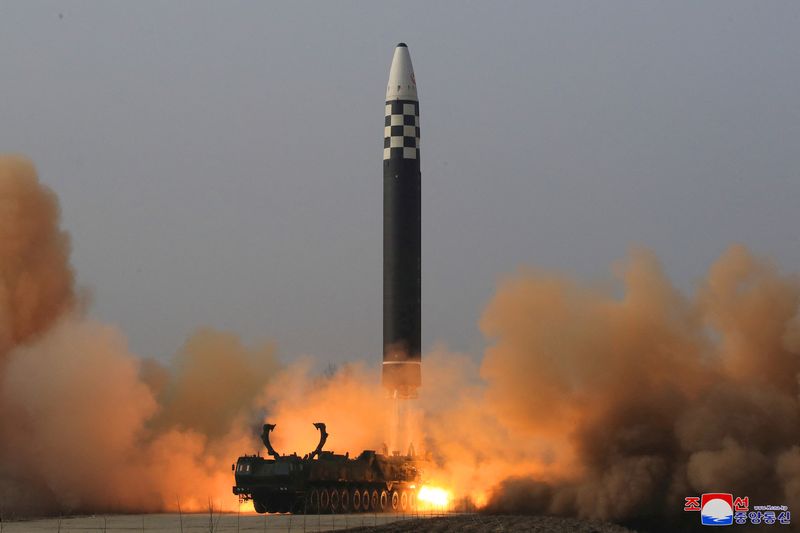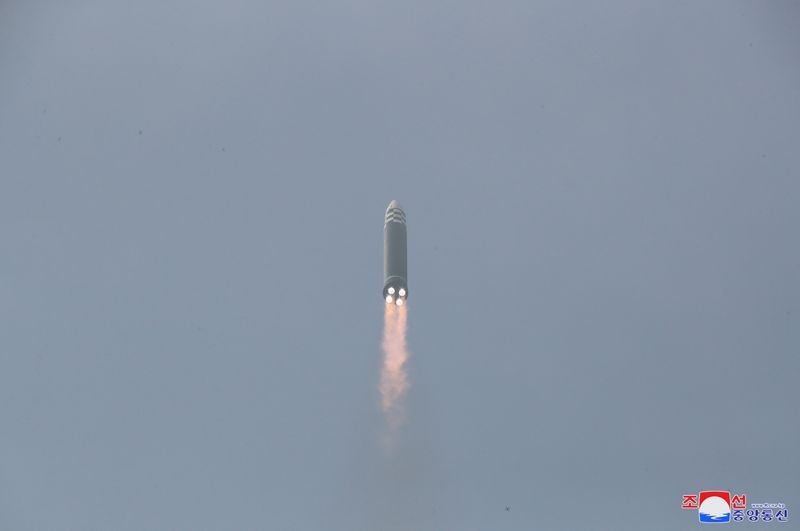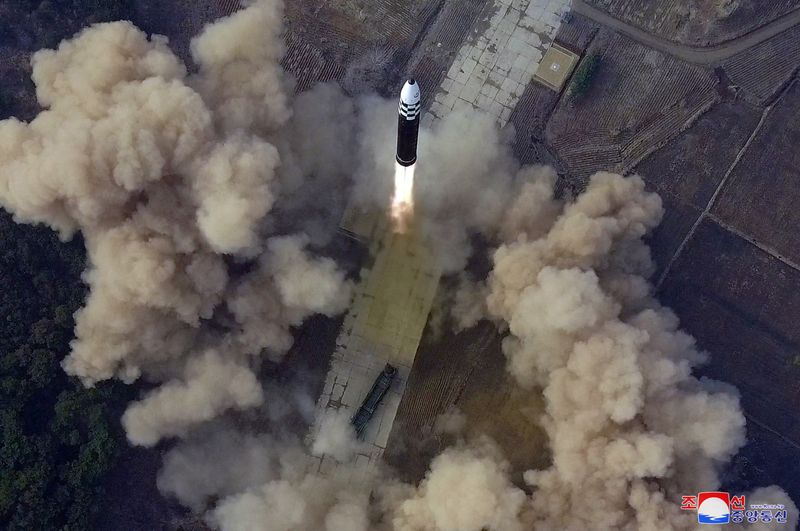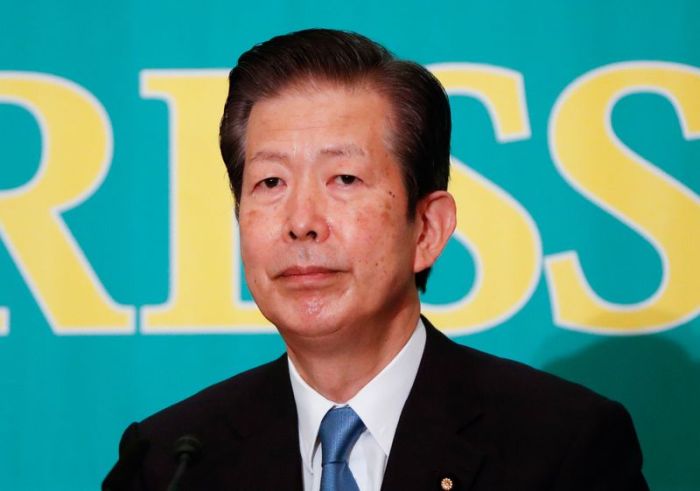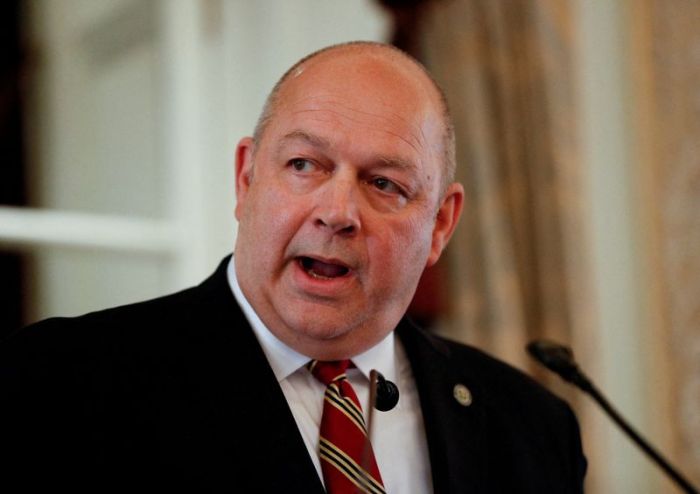SEOUL (Reuters) -North Korea said it tested a new, powerful type of intercontinental ballistic missile on Thursday, marking an end to a self-imposed moratorium on long-range testing in place since 2017 and drawing international condemnation.
State media said leader Kim Jong Un directly guided the test of the Hwasong-17, a “new type” of intercontinental ballistic missile that is North Korea’s biggest ever. He said it was key to deterring nuclear war.
It said the missile flew for 1,090 km (681 miles) to a maximum altitude of 6,248.5 km (3,905 miles) and precisely hit a target in the sea.
Kim said North Korea was preparing for long confrontation with U.S. imperialism and its strategic force was ready to check and contain any military attempt by the United States, North Korean media said.
Flight data from the South Korean and Japanese militaries earlier indicated the missile flew higher and for a longer time than any of North Korea’s previous tests before crashing into the sea west of Japan.
It was the first full-capability launch of the nuclear-armed state’s largest missiles since 2017, and represents a major step in Pyongyang’s development of weapons that might be able to deliver nuclear warheads anywhere in the United States.
North Korea’s return to major weapons tests poses a new headache for U.S. President Joe Biden as he responds to Russia’s invasion of Ukraine, and presents a challenge to South Korea’s incoming conservative administration.
Biden and Japanese Prime Minister Fumio Kishida, meeting at a Group of Seven summit in Brussels in a show of unity against the Kremlin’s war, condemned the North Korean launch, stressed the need for diplomacy and agreed to work together to hold Pyongyang “accountable,” a White House official said.
“This launch is a brazen violation of multiple U.N. Security Council resolutions and needlessly raises tensions and risks destabilising the security situation in the region,” White House press secretary Jen Psaki said earlier.
North Korea had put its ICBM and nuclear tests on hold since 2017, but has defended the weapons as necessary for self-defence. Amid stalled denuclearisation efforts Biden has been unable to jumpstart, Pyongyang has called U.S. overtures insincere while its maintains “hostile policies” such as sanctions and military drills.
North Korea’s launch missile was a jarring reminder that its leader Kim Jong Un will not be ignored even as the world’s attention is gripped by the Ukraine crisis.
South Korea’s outgoing President Moon Jae-in, who made engaging North Korea a major goal, condemned the launch as “a breach of the moratorium on ICBM launches that Chairman Kim Jong Un himself promised to the international community”. Moon is due to leave office in May.
Kishida called it an “unacceptable act of violence.”
The launch prompted South Korea to test-fire a volley of its own, smaller ballistic and air-to-ground missiles to demonstrate it has the “capability and readiness” to precisely strike missile launch sites, command and support facilities, and other targets in North Korea if necessary, South Korea’s military said.
U.S. Secretary of State Antony Blinken and South Korean Foreign Minister Chung Eui-yong called for a decisive response and agreed that additional measures by the U.N. Security Council were essential, South Korea’s foreign ministry said.
U.S. Defense Secretary Lloyd Austin and his South Korean counterpart also spoke and agreed that a firm response was necessary, the Pentagon said. It said Austin also spoke with his Japanese counterpart.
In a statement to a Senate Armed Services Committee hearing, General Glen VanHerck, head of the U.S. Northern Command, said North Korea’s “ongoing development of increasingly complex and capable strategic weapons” showed the need for on-time or early deployment of a next generation missile defence interceptor and for a new long-range radar in Alaska to achieve full operational capacity on schedule.
The United States, Britain, France, Ireland, Albania and Norway asked the U.N. Security Council to hold a public meeting on Friday to discuss the launch and U.N. Secretary-General Antonio Guterres urged Pyongyang “to desist from taking any further counter-productive actions.”
However, securing a tough international response to North Korea’s latest ICBM launch will be far more difficult for Washington than in 2017. World powers capable of imposing new U.N. sanctions on Pyongyang, as they did then, are at odds over Ukraine and appear unlikely to find common ground. [nL5N2VR4T3}
NEW ICBM?
Japanese authorities said the launch appeared to be a “new type” of ICBM that flew for about 71 minutes to an altitude of about 6,000 km (3,728 miles) and a range of 1,100 km (684 miles).
It landed inside Japan’s exclusive economic zone (EEZ), 170 km (106 miles) west of the northern prefecture of Aomori, at 3:44 p.m. (0644 GMT), the coast guard said.
South Korea’s Joint Chiefs of Staff put the missile’s maximum altitude at 6,200 km and its range at 1,080 km.
That is further and longer than North Korea’s last ICBM test in 2017, when it launched a Hwasong-15 missile that flew for 53 minutes to an altitude of about 4,475 km and range of 950 km.
South Korea’s military said the latest missile was launched from near Sunan, where Pyongyang’s international airport is located. On March 16, North Korea launched a suspected missile from that airport that appeared to explode shortly after liftoff, South Korea’s military said.
U.S. and South Korean officials warned this month that North Korea was preparing to test-fire the Hwasong-17, its largest ICBM. U.S. officials said two recent tests featured the Hwasong-17 system, but did not demonstrate full ICBM range or capability.
Pyongyang said at the time it was testing components for a reconnaissance satellite system.
Amid a flurry of diplomacy in 2018, Kim declared a moratorium on testing ICBMs and nuclear weapons, but later suggested such tests could resume amid stalled denuclearisation talks.
That moratorium had often been touted as a success by former U.S. President Donald Trump, who held historic summits with Kim in 2018 and 2019, but never secured a concrete pact to limit North Korea’s nuclear or missile arsenals.
New construction has also been spotted at North Korea’s only known nuclear test site, which was shuttered in 2018.
The possibility of resumed nuclear tests, more joint U.S.-South Korea military drills, and a new conservative South Korean president mean “all conditions are present for a tit-for-tat chain reaction of escalatory steps”, said Chad O’Carroll, CEO of Korea Risk Group, which monitors North Korea.
(Reporting by Josh Smith, Hyonhee Shin, and Ju-min Park in Seoul, Sakura Murakami in Tokyo, Trevor Hunnicutt and David Brunnstrom in Washington and Michelle Nichols in New York; Writing by Matt Spetalnick; Editing by Gerry Doyle and Alistair Bell)

